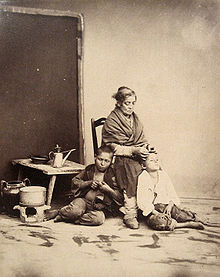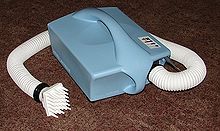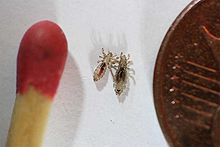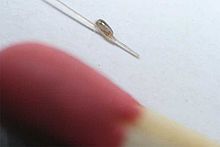- School head lice policy
-
A heated air device for the community-level management of pediculosis[1]

School head lice policy is a set of rules and guidelines designed to minimize transmission and incidence of head-louse infestation in school settings. Similar policies are implemented at summer camps, day care facilities, and other locations where large numbers of children come into close contact. The most well-known aspect of school head lice policy is the "no-nit policy". This policy bars children from attendance if they are found to have nits in their hair—a sign of head-louse infestation (pediculosis).[2]
School head lice policy involves a number of issues:
- Circumstances under which children will be inspected
- Criteria to infer infestation
- Procedures for dealing with infested children upon discovery
- Criteria to permit previously infested children to return to school (e.g., the no-nit policy)
These issues are controversial. In particular, a number of health researchers and organizations object to the required removal of nits (i.e., the no-nit policy).[2][3][4][5] Opponents to the no-nit policy point out that nits, being empty eggshells, have no clinical importance.[2] Time-consuming nit removal, therefore, has no direct effect on transmission. This has led to the perception that the no-nit policy serves only to ease the workload of school nurses.[2] Proponents of the no-nit policy counter that only a consistently nit-free child can be reliably shown to be infestation-free.[6] That is, the presence of nits serves as a proxy for infestation status. Proponents argue that such a proxy is necessary because lice screening is prone to false negative conclusions (i.e., failure to find lice present on actively infested children).[3][7][8]
Contributing to the controversial nature of school head lice policies is a lack of available data on their importance and efficacy. For example, as of 2008[update], the transmissibility of head lice in school settings is largely unknown.[9] Further, control-matched studies of the effect of specific school policies on head lice incidence are also lacking.[10]
Schools in developed countries such as the United States, Canada, and Australia commonly exclude infested students, and prevent return of those students until all lice, eggs, and nits are removed.[2] Policies in the United Kingdom extend to legal action against parents of infested students.[11][12] Attitudes in developing countries are often quite different. Many societies consider head louse infestation to be normal, if even remarked upon at all.[11][13]
Contents
Motivation and scope
“ ...it is generally considered that the source of most infestations is at the school... ” —Norman G. Gratz, 1997[11]
Most westernized countries consider head louse infestation to be undesirable,[13] and eradication of head lice among school children has been a public health goal since before the first world war.[14] Head louse infestation occurs primarily in children,[8][9][15] so minimizing transmission in this age group is potentially the most cost-effective way of controlling head lice epidemics.
To this end, schools have implemented policies designed to identify, isolate, and treat students. Unfortunately, this basic outline is complicated by a number of controversial issues. As of 2008, no uniform school head lice policy is implemented worldwide, and researchers disagree as to the most appropriate policies. Contributing to this controversy is a lack of data on fundamental questions concerning communicability of head lice in school settings, and the efficacy of particular school policies.
School head lice policies deal with a number of issues, most of which are controversial:
- Circumstances under which children will be inspected
- Criteria to infer infestation
- Procedures for dealing with infested children upon discovery
- Criteria to permit previously infested children to return to school (e.g., the "no-nit" policy)
Screening
Screening motivation
Although itching (pruritus) is a common symptom of head louse infestation,[16] it is a poor criterion upon which to base inspection.[7] The majority of infested children do not report itching. For example, a 1991 Israeli study found that only 36% of infested children reported itching.[17][18] Other data suggest that, if anything, itch reporting by children is even less.[16][17] Contributing to the apparently low incidence of itch may be the reluctance of children to report this known symptom of louse infestation.[17] Infestation is also known to lead to secondary conditions such as lymphadenopathy, eczema, and impetigo, but these signs take time to develop, are more difficult to assess than itching, and are often absent.[17]
For these reasons, routine screening of asymptomatic children is advocated by a variety of nurses, researchers, organizations, and governments.[2][6][19][20] Support for asymptomatic screening comes from both supporters[6] and opponents[2][19] of no-nit policies.
Screening prevalence and frequency
Despite these recommendations, routine screening at schools is uncommon. A 1991 survey of American nurses reported that only 27% have regular screening programs in place at their schools.[21] This being despite the fact that 65% bar students with nits from returning to school.[21] 85% reported screening on an "as-needed" basis.[9][21]
School screening advocates encourage screenings to coincide with the return of children to school after vacations.[19][20] The absence of children from school during vacation provides a natural disinfection process for the classrooms. Head lice cannot live more than a day or two away from a host.[22][23] Any remaining eggs will hatch in one to two weeks,[16][23][24] and absent a host, the emerging nymphs will die within hours.[13] Thus, simply leaving the school vacant for a week or two is sufficient to disinfect all fomite sources of head louse infection. The return of children to this now-clean environment is an ideal time to screen for infestations and attempt to keep the environment lice-free.[20]
The California Department of Public Health encourages screenings to be performed on Fridays.[19] This allows infested students to be treated over the weekend, potentially minimizing student absenteeism.
Screening controversy
Some health researchers oppose asymptomatic screening.[4][5] This opposition to school screening coincides with opposition to no-nit policies, and is based on similar reasoning (i.e., that they are ineffective).[3]
Head lice screening programs have not had a significant effect on the incidence of head lice in the school setting over time and have not proven to be cost effective.—National Association of School Nurses (2004)[5]Lice infestation is not a reportable disease, so data on head lice incidence are sparse.[21][25][26] As of 2008[update], no control-matched study exists on the effect of school screening programs on head lice prevalence.[10] Further, although some authors note a stubborn prevalence of head lice during the latter half of the 20th century,[18] this has occurred in an environment of rather lax screening efforts. For example, a 1991 survey of American nurses reported that only 27% had regular screening programs in place at their schools.[21] Anecdotal evidence suggests that school screening programs can reduce head lice prevalence.[18][27][28] Certainly, the effectiveness of these programs must be determined before their cost effectiveness can be evaluated.
Barbara Frankowski, a critic of school screenings, argues that time spent screening children by school nurses is better spent on other tasks.[4] This attitude reflects those held by some American school nurses themselves, 27% of whom believe that eliminating lice infestations in not an important role of school nursing.[29] Even more telling, only 11% of American school nurses find treating head lice to be professionally gratifying.[29] Similar attitudes exist among Canadian school nurses.[27]
“ No child should be allowed to miss valuable school time because of head lice. ” —American Academy of Pediatrics, 2002[3]
School inspections are often short—about one minute per child.[3][20] Frankowski argues that such inspections are not thorough enough to be accurate, and so may lead to a false sense of security.[3] Indeed, a 1998 study of Israeli children found that live lice took an average of 57 - 116 seconds to detect depending on the technique used.[30] L. Keoki Williams and others acknowledge this shortcoming of school screening, and suggest that children found to have nits undergo an additional 5- to 10-minute examination to exclude the presence of live lice.[31] In contrast, the American Academy of Pediatrics (AAP) argues not for increased inspection time, but elimination of the school screenings altogether, with parents being educated and encouraged to inspect their own children at home.[4] This attitude, coupled with the AAP's opposition to the no-nit policy,[4] would essentially absolve school administrators of responsibility to directly manage pediculosis in their student body.
Criteria to infer infestation
What is a "nit"?
See also: Nits (lice)A nit is generally known as the egg of a louse. However, with respect to the communicability of head lice, whether an egg contains a viable embryo or not is eminently relevant. Extinct infestations may leave a host with hundreds of eggshells that are empty (or will never hatch) attached to the host's hair. This holdover from prior infestation will remain until physically removed, but poses no risk of transmission or re-infestation.[16]
Some authors have restricted their definition of a nit to these persistent and non-infectious eggshells.[2][10][12] In turn, these authors refer to "eggs" as being those that are likely to hatch and are therefore potentially infectious.
Unfortunately, not all authors share this view.[7][18][31][32] In part, this unwillingness to differentiate between infectious and non-infectious "nits" stems from the notorious difficulty in properly identifying them by visual means.[10][18][33] Thus, the uncertainty of the term "nit" is a reflection of the uncertainty in differentiating louse eggs.
These differences in language mean that assertions about the relevance of nits to infestation cannot be given without precise qualifications.
Diagnosis
Only the presence of live crawling lice (nymph or imago) constitutes an infestation.[10][15][31] Much of the controversy surrounding school head lice policy centers on the question of what to do with children discovered to have nits, but no visible lice. Indeed, one-third to three-fourths of children with nits fall into this category.[15][22][30][31] The nits-only population therefore represents a significant fraction of children potentially subject to school exclusion and/or treatment with insecticides. Such children have evidence of infestation (i.e., the nits), but the infestation may be extinct.
Unfortunately, false negative conclusions (i.e., failing to find lice that are, in fact, present) regarding infestation have long been recognized as a problem in head lice diagnosis.[8][9][16][30] Depending on the methods used, live lice can be easily missed during inspection.[3][7] For example, a 1998 Israeli study found that 76% of live lice infestations were missed by visual inspection (as verified by subsequent combing methods).[9][30] Although lice cannot fly or jump, they are fast and agile in their native environment (i.e., clinging to hairs near the warmth of the scalp),[3][12] and will try to avoid the light used during inspection.[34][35] Lice populations are also sparse, which can contribute to difficulty in finding live specimens.[15] Two-thirds of infestations are composed of 10 of fewer individual lice.[15][36] Further, lice populations consist predominantly (80%-90%) of immature nymphs,[36] which are even smaller and harder to detect than adult lice.[30]
These difficulties have, at times, lead to the recommendation that the presence of nits alone be used to infer infestation:
When nymphs or adults are not observed, the presence of nits is diagnostic.—U.S. Centers for Disease Control, 1984[37]But in terms of school policy, the general questions regarding nits-only students remain:
- Should these students be excluded?
- Should schools require these students be treated?
Significance of nits
A 1998 American study attempted to clarify the infestation risk associated with a "nits-only" diagnosis. They found that 18% of children with nits (but no apparent lice) became infested (i.e., lice appeared) 14 days later.[31] Whether these new lice came from viable eggs or via transmission from other hosts was not clear.[31] Transmission from other hosts would tend to overestimate the infestation risk associated with nits. In addition, some children were treated with pediculicides during this 14 day period.[31] Successful treatments (i.e., killing eggs or recently-hatched nymphs) would tend to underestimate the infestation risk associated with nits. These limitations of the study notwithstanding, the authors concluded:
Most children with nits alone will not become infested; therefore, excluding these children from school and requiring them to be treated with a pediculicide is probably excessive.—L. Keoki Williams and others (2001)[31]Benefits of nit-free population
Although "nits-only" children are unlikely to become infested, this is not to say that a nit-free population is without value. Much of the difficulty in accurately diagnosing head lice stems from the possibility that observed nits are due to an extinct infestation. However, if a policy of required nit removal is enforced, this is no longer an issue. Against a background of nit-free children, spotting new infestations through routine screening becomes as easy as spotting the nits.[32] This ease in screening comes at a price, though, namely the effort expended (typically by parents) in removing nits. And to the extent that no-nit policies result in absenteeism, the child's education suffers, and the school's funding (e.g., from government sources) may be reduced.[2][38]
Discovery of infested students
Immediate exclusion from school
Discovery of infested students typically occurs during a school day. Assuming the presence of live lice is the criteria used to infer infestation, an ethical dilemma is presented to school nurses and administrators. Should this student, now known to be infectious, be returned to class where transmission to other students could occur? Or alternatively, should the student be immediately removed from the group setting? Schools have very limited capacity to individually supervise students outside of the classroom, so removal from the classroom means requesting that the child's parents pick up their child.
Parents often become upset when the school nurse telephones their place of employment to inform them of their child's infestation and to request they come and collect their child.[20] Nonetheless, immediate exclusion policies are explicitly advocated by some nurses.[20] A 1998 survey revealed that almost all (96%) American school nurses send home infested students upon discovery.[21][29]
Opponents to immediate exclusion policies point out that the discovery of infestation is merely recognition of what has been an infectious condition for a number of months.[2][12] Given that context, they argue, one more day of group contact is unlikely to result in more transmission than has already occurred.[2][12] This contrasts with more short-term and highly communicable viral diseases such as chickenpox, influenza, or measles where immediate exclusion might reasonably reduce disease spread within the school.[citation needed]
The value of immediate exclusion for lice depends to some extent on the frequency of asymptomatic screening at the school. More frequent screening would tend to decrease the average time between infestation and discovery of that infestation. This would make the one day associated with immediate exclusion a more significant fraction of the total time the student was infectious. But even ardent supporters of asymptomatic screening do not advocate screenings more than once every three months.[20] This suggests that the effect of immediate exclusion might be an exposure time reduction of as little as 1.6%, even under strict screening guidelines.[39]
These changing attitudes on immediate exclusion appear to be affecting public policy. For example, in Australia, the National Health and Medical Research Council states that infested children need not be sent home upon discovery.[7] Similarly, the California Department of Public Health advocates a head lice policy that does not immediately exclude infested children.[19]
Communicability in school settings
Evaluating immediate exclusion policies is difficult, because as of 2008[update] the communicability of head lice in school settings has not been carefully studied.[9] This has not, however, prevented authors from confidently asserting their opinion:
In some areas... crowded conditions at home may predispose persons to head lice. Nevertheless, evidence indicates that most transmission actually occurs at school.—Norman G. Gratz, 1997[11]Lice transmission in schools is rare because close head-to-head contact would have to occur and this generally does not happen in the school setting.—Patricia Sciscione and Cheryl A. Krause-Parello, 2007[40]Two studies have noted clustering of head louse infestation by classroom.[9][41] However, the authors differ in their interpretation of this clustering. In 1997, Richard Speare and Petra Buettner noted prevalence ranges of 0% to 72.2% across classrooms in the same grade (3rd) and in the same Australian school. This led them to favor the idea that "opportunities for transmission are prominent within the classroom".[41] Indeed, their data suggest that classrooms synchronize in terms of infestation status.
In contrast, Janis Hootman suggests that school communicability is low.[9] In 1998 she found that infestations within American classrooms were restricted to a minority of chronically-infested students. Hootman concluded that the infested students have access to an infectious source that their classmates do not. Similarly, she found that clusters of pediculosis within classrooms were associated social interactions outside school (e.g., sleepovers).[9] This indicates that transmission can occur between classmates, but again, these transmission events may be occurring away from school grounds.
Barring return to school
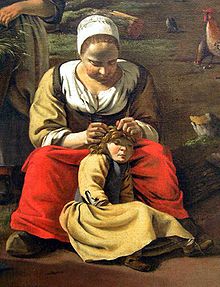 Detail of a woman picking lice from a child's head. From Cour de ferme (1662) by Jan Siberechts
Detail of a woman picking lice from a child's head. From Cour de ferme (1662) by Jan Siberechts
After identifying and isolating an infested student, school policy typically requires some sort of verification that the student is no longer infectious before being readmitted to the school. Typically, this involves inspecting the child for evidence of continued infestation (see Criteria to infer infestation above). Schools commonly enforce either a "no-nit" policy or a "no-lice" policy.
The no-nit policy
No-nit policies bar readmission of students found to have lice, eggs, or nits. This policy is popular with health authorities in the United States, Canada, and Australia.[2] A 1998 survey revealed that a majority (61%) of American school nurses prevent return of treated students to school if they are not (also) nit-free.[21][29] A similar percentage (60%) felt that "forced absenteeism of any child who has any nits in their hair is a good idea."[29] Data from a primarily American study during 1998-1999 revealed even higher prevalence -- no-nit policies were present at 82% of the schools attended by children suspected of louse infestation.[33]
James H. Price and colleagues estimate that infested students lose two to four days of school for treatment and nit removal.[29] Based on their 1998 survey of American school nurses, they estimate that approximately 6 million U.S. children lose 12 to 24 million child-schooldays annually due to lice infestation under no-nit policies.[29]
Controversy surrounding no-nit policy
“ The no-nit policies may appeal to laypersons, and it is difficult to explain why they are not effective, particularly when some consumer organizations strongly support them. Nevertheless, there is no scientific basis to confirm the effectiveness of such programs... ” —Barbara L. Frankowski (2004)[4]
Although the no-nit policy has the appearance of a simple and popular tool against pediculosis transmission, its implementation has been opposed by a number of health researchers and organizations.[2][3][4][5] Opponents argue that enforcement of no-nit policies has not significantly reduced head lice incidence in school settings,[3] and that the risks and disadvantages of the no-nit policies outweigh their associated benefits.[2]
As is the case in assessing school screening efforts (see Screening above), assessing the effectiveness of no-nit policies is complicated by the sparseness of head lice prevalence data.[21][25] To the extent that no-nit policies increase the efficiency of school screening programs (see Benefits of nit-free population above), no-nit policies may lead to more rapid containment of head lice outbreaks. However, as of 2008[update], the correlation between no-nit policies and head lice incidence has not been examined.
Inherent conflict over no-nit policy
Kosta Y. Mumcuoglu and colleagues indict required nit removal policies as an attempt to minimize the effort expended by school nurses on differentiating active and extinct infestations.[2] They further argue that this minimization comes at the expense of excessive efforts on the part of parents to remove signs of previous infestations (i.e., the nits), which have no clinical importance.[2]
The difficulty parents face in advocating more lax attitudes towards children with nits, is that the parents have no concomitant guarantee from school administrators that those admitted children will truly be lice-free. Indeed, admitting children with nits increases the difficulty in identifying actively infested students (see Criteria to infer infestation above). In contrast to diseases such as measles or influenza, pediculosis does not inherently prevent school attendance. The financial incentive for schools, therefore, is to minimize expenditures on lice control and screening programs because (absent a no-nit policy) they have little effect on attendance.[40] This is a formula for maximizing lice infestation within the student body, not minimizing it. Thus, while the no-nit policy may be seen as off-loading school nurse responsibilities to parents,[2] it is perhaps more correctly viewed as imposing parental priorities on school administrators.
In the absence of such policies, school and parental priorities with respect to lice are inherently at odds. The parents wish to minimize lice transmission. In contrast, schools wish to maximize attendance, which is largely unaffected by lice transmission. Barring return of children until nits are removed has the effect of transforming the pediculosis "problem" for which schools have no inherent incentive to solve, into an attendance "problem" for which schools have a direct financial interest. Unfortunately, the solution advocated by many to this attendance "problem" is to simply remove the no-nit policy,[3] leaving the inherent conflict between parents and school administrators unaddressed.
The no-lice policy
The no-lice policy bars readmission of students with crawling lice, but are indifferent to the presence of eggs and nits. These policies are advocated by a number of government agencies, but as of 2008[update], no data on the overall prevalence of no-lice policies exists. In Australia, the National Health and Medical Research Council states that treated children can return with nits so long as they are lice-free.[7] Similarly, the California Department of Public Health advocates a policy that permits students to return to school with nits.[19]
See also
References
- ^ Goates BM et al., BM; Atkin, JS; Wilding, KG; Birch, KG; Cottam, MR; Bush, SE; Clayton, DH (2006). "An Effective Nonchemical Treatment for Head Lice: A Lot of Hot Air". Pediatrics (American Academy of Pediatrics) 118 (5): 1962–1970. doi:10.1542/peds.2005-1847. PMID 17079567. http://www.zoologia.hu/pediatrics.pdf. Retrieved 2010-08-02.
- ^ a b c d e f g h i j k l m n o p q Mumcuoglu, Kosta Y.; Meinking, Terri A; Burkhart, Craig N; Burkhart, Craig G. (2006). "Head Louse Infestations: The "No Nit" Policy and Its Consequences". International Journal of Dermatology (International Society of Dermatology) 45 (8): 891–896. doi:10.1111/j.1365-4632.2006.02827.x. PMID 16911370. http://www.blackwell-synergy.com/doi/pdf/10.1111/j.1365-4632.2006.02827.x.
- ^ a b c d e f g h i j k Frankowski, Barbara L.; Leonard B. Weiner, the Committee on School Health, the Committee on Infectious Diseases (September 2002). "Head Lice: American Academy of Pediatrics Clinical Report". Pediatrics (American Academy of Pediatrics) 110 (3): 638–643. ISSN 0031-4005. PMID 12205271. http://aappolicy.aappublications.org/cgi/content/full/pediatrics;110/3/638. Retrieved 2008-10-10.
- ^ a b c d e f g Frankowski, Barbara L. (September 2004). "American Academy of Pediatrics guidelines for the prevention and treatement of head lice infestation". The American Journal of Managed Care 10 (9): S269–S272. PMID 15515631. http://www.ajmc.com/article.cfm?ID=2704&CFID=14635274&CFTOKEN=65325173. Retrieved 2008-10-10.
- ^ a b c d National Association of School Nurses (July 2004). "Pediculosis in the School Community: Position Statement". Silver Spring, Maryland: National Association of School Nurses. http://www.nasn.org/Default.aspx?tabid=237. Retrieved 2008-10-10.
- ^ a b c "The No Nit Policy: A Healthy Standard for Children and their Families". The National Pediculosis Association. 2008. http://www.headlice.org/downloads/nonitpolicy.htm. Retrieved 2008-10-12.
- ^ a b c d e f National Health and Medical Research Council (December 2005) (PDF). Staying Healthy in Child Care: Preventing infectious diseases in child care (4th ed.). Commonwealth of Australia. ISBN 0642456313. http://www.nhmrc.gov.au/publications/synopses/_files/ch43.pdf.
- ^ a b c Greenough FB (1887). "Clinical notes on pediculosis". Boston Medical and Surgical Journal 117 (20): 469–474.
- ^ a b c d e f g h i Hootman J (April 2002). "Quality improvement projects related to pediculosis management" ([dead link]). The Journal of school nursing : the official publication of the National Association of School Nurses 18 (2): 80–6. PMID 12017250. http://jsn.sagepub.com/cgi/pmidlookup?view=long&pmid=12017250.
- ^ a b c d e Burgess, Ian (2004). "Human Lice and their Control". Annual Review of Entomology (Annual Reviews) 49: 457–481. doi:10.1146/annurev.ento.49.061802.123253. PMID 14651472. http://arjournals.annualreviews.org/doi/pdf/10.1146/annurev.ento.49.061802.123253.
- ^ a b c d Gratz, Norman G. (1997) (PDF). Human Lice. Their prevalence, control and resistance to insecticides. A review 1985 - 1997.. World Health Organization. http://whqlibdoc.who.int/hq/1997/WHO_CTD_WHOPES_97.8.pdf.
- ^ a b c d e Maunder, JW (1983). "The Appreciation of Lice". Proceedings of the Royal Institution of Great Britain (London: Royal Institution of Great Britain) 55: 1–31.[unreliable source?]
- ^ a b c Meinking, Terri; David Taplin (1995). "Infestations". In Lawrence A. Schachner and Ronald C. Hansen. Pediatric Dermatology. Volume 2 (2nd ed.). New York: Churchill Livingstone. pp. 1347–1392.
- ^ Sobel, Jacob (1913). "Pediculosis capitis among school children". New York Medical Journal 48: 656–664.
- ^ a b c d e Mumcuoglu KY, Miller J, Gofin R, et al. (September 1990). "Epidemiological studies on head lice infestation in Israel. I. Parasitological examination of children". International journal of dermatology 29 (7): 502–6. doi:10.1111/j.1365-4362.1990.tb04845.x. PMID 2228380. http://www.blackwell-synergy.com/doi/pdf/10.1111/j.1365-4362.1990.tb04845.x.
- ^ a b c d e Burgess IF (1995). "Human lice and their management". Advances in Parasitology 36: 271–342. doi:10.1016/S0065-308X(08)60493-5. PMID 7484466.
- ^ a b c d Mumcuoglu KY, Klaus S, Kafka D, Teiler M, Miller J (August 1991). "Clinical observations related to head lice infestation". Journal of the American Academy of Dermatology 25 (2 Pt 1): 248–51. doi:10.1016/0190-9622(91)70190-D. PMID 1918461.
- ^ a b c d e Meinking, Terri Lynn (May/June 1999). "Infestations". Current Problems in Dermatology 11 (3): 75–118. doi:10.1016/S1040-0486(99)90005-4.
- ^ a b c d e f Infectious Diseases Branch, Division of Communicable Disease Control (2007). "Guidelines on head lice prevention and control for school districts and child care facilities" (pdf). California Department of Public Health. pp. 1–4. http://www.cdph.ca.gov/HealthInfo/discond/Documents/2007SchoolGuidelinesonHeadLice.pdf. Retrieved 2008-10-10.[dead link]
- ^ a b c d e f g Clore, Ellen Rudy; Leah Ann Longyear (May 1990). "Comprehensive pediculosis screening programs for elementary schools". Journal of School Health 60 (5): 212–214. doi:10.1111/j.1746-1561.1990.tb05917.x. PMID 2366522.
- ^ a b c d e f g h Donnelly E, Lipkin J, Clore ER, Altschuler DZ (1991). "Pediculosis prevention and control strategies of community health and school nurses: a descriptive study". Journal of community health nursing 8 (2): 85–95. doi:10.1207/s15327655jchn0802_4. PMID 2033411. http://www.jstor.org/sici?sici=0737-0016(1991)8:2%3C85:PPACSO%3E2.0.CO;2-&cookieSet=1.
- ^ a b Chunge RU, Scott FE, Underwood JE, Zavarella KJ (1991). "A pilot study to investigate transmission of headlice". Canadian Journal of Public Health 82: 207–208.
- ^ a b Meinking, Terri L.; Taplin D, Kalter DC, Eberle MW (1986). "Comparative efficacy of treatments of pediculosis capitis infestations". Arch Dermatol 122 (3): 267–271. doi:10.1001/archderm.122.3.267. PMID 2420284.
- ^ Leeson HS (1941). "The effect of temperature upon the hatching of the eggs of Pediculus humanus corporis De Geer (Anoplura)". Parasitology 33: 243–249. doi:10.1017/S0031182000024434.
- ^ a b Billstein S, Laone P (1979). "Demographic study of head lice infestations in Sacramento County school children.". International Journal of Dermatology 18 (4): 301–304. doi:10.1111/j.1365-4362.1979.tb01933.x. PMID 457325.
- ^ Koch T, Brown M, Selim P, Isam C (May 2001). "Towards the eradication of head lice: literature review and research agenda". J Clin Nurs 10 (3): 364–71. doi:10.1046/j.1365-2702.2001.00512.x. PMID 11820546. http://www3.interscience.wiley.com/resolve/openurl?genre=article&sid=nlm:pubmed&issn=0962-1067&date=2001&volume=10&issue=3&spage=364.
- ^ a b Mathias RG, Wallace JF (1989). "Control of headlice: using parent volunteers". Can J Public Health 80 (6): 461–3. PMID 2611749.
- ^ Scott P, Gilmer MJ, Johannessen WM (March 2004). "The Nit Rating Scale". The Journal of school health 74 (3): 108–10. doi:10.1111/j.1746-1561.2004.tb04213.x. PMID 15137271.
- ^ a b c d e f g Price JH, Burkhart CN, Burkhart CG, Islam R (April 1999). "School nurses' perceptions of and experiences with head lice". The Journal of school health 69 (4): 153–8. doi:10.1111/j.1746-1561.1999.tb04174.x. PMID 10354985. http://web.ebscohost.com/ehost/pdf?vid=2&hid=6&sid=1f619cd3-ab51-4f65-9f31-8aae5e14dc6b%40sessionmgr7. Retrieved 2008-10-10.
- ^ a b c d e Mumcuoglu KY, Friger M, Ioffe-Uspensky I, Ben-Ishai F, Miller J (2001). "Louse comb versus direct visual examination for the diagnosis of head louse infestations". Pediatric dermatology 18 (1): 9–12. doi:10.1046/j.1525-1470.2001.018001009.x. PMID 11207962. http://www.blackwell-synergy.com/openurl?genre=article&sid=nlm:pubmed&issn=0736-8046&date=2001&volume=18&issue=1&spage=9.
- ^ a b c d e f g h Williams LK, Reichert A, MacKenzie WR, Hightower AW, Blake PA (2001). "Lice, nits, and school policy". Pediatrics 107 (5): 1011–5. doi:10.1542/peds.107.5.1011. PMID 11331679.
- ^ a b Brainerd, E (April 1998). "From eradication to resistance: five continuing concerns about pediculosis". Journal of School Health 68 (4): 146–50. doi:10.1111/j.1746-1561.1998.tb06332.x. ISSN 0022-4391. PMID 9644607.
- ^ a b Pollack RJ, Kiszewski AE, Spielman A (2000). "Overdiagnosis and consequent mismanagement of head louse infestations in North America". Pediatr. Infect. Dis. J. 19 (8): 689–93. doi:10.1097/00006454-200008000-00003. PMID 10959734.
- ^ Bacot A (1917). "Contributions to the bionomics of Pediculus humanus (vestimenti) and Pediculus capitis". Parasitology 9: 228–258. doi:10.1017/S0031182000006065.
- ^ Nuttall, George H. F. (1919). "The biology of Pediculus humanus, Supplementary notes". Parasitology 11 (2): 201–221.
- ^ a b Buxton, P. A. (1941). "Studies on populations of head-lice (Pediculus humanus capitis: Anoplura) IV. The composition of populations". Parasitology 33: 224–242.
- ^ Darsie RE, ed (1984). Controlling Head Lice. HHS Publication No. (CDC) 84-8397. (2nd ed.). Atlanta, GA: Center for Disease Control, U.S. Department of Health and Human Services. pp. 15 pages.
- ^ "Dollars to Districts". Mountain View, CA: EdSource. http://www.edsource.org/iss_fin_sys_dollarstodistricts.html. Retrieved 2008-12-22.
- ^ Three months includes approximately 90 days, which in turn includes approximately 64 weekdays. One out of 64 days is 0.0156 or 1.6%.
- ^ a b Sciscione, Patricia; Krause-Parello CA (2007). "No-nit policies in schools: Time for change". The Journal of School Nursing 23 (1): 13–20. doi:10.1177/10598405070230010301. PMID 17253890.
- ^ a b Speare, Richard; Buettner, PG (1999). "Head lice in pupils of a primary school in Australia and implications for control". International Journal of Dermatology (International Society of Dermatology) 38 (4): 285–290. doi:10.1046/j.1365-4362.1999.00680.x. PMID 10321945.
Categories:
Wikimedia Foundation. 2010.

